Comprehensive Literature Review: Procurement and its Dynamics
VerifiedAdded on 2022/09/13
|6
|1602
|107
Literature Review
AI Summary
This literature review examines the multifaceted process of procurement, encompassing supplier selection, contract negotiation, and the historical evolution of supply chain management. It begins by defining procurement and its key components, including vendor selection, payment terms, and strategic vetting. The review highlights the importance of strategic alliances in facilitating deals and mitigating risks within the supply chain. It also discusses methods for resolving disputes, advocating for out-of-court settlements to avoid costly litigation. The review analyzes research on supplier selection criteria, emphasizing qualifications, experience, and pricing. While the review covers several aspects of procurement, it identifies gaps in the literature regarding deal negotiation strategies and factors influencing supply chain operations, suggesting areas for future research. The paper references several key research papers and concludes that a deeper understanding of procurement and supply chain processes is needed.
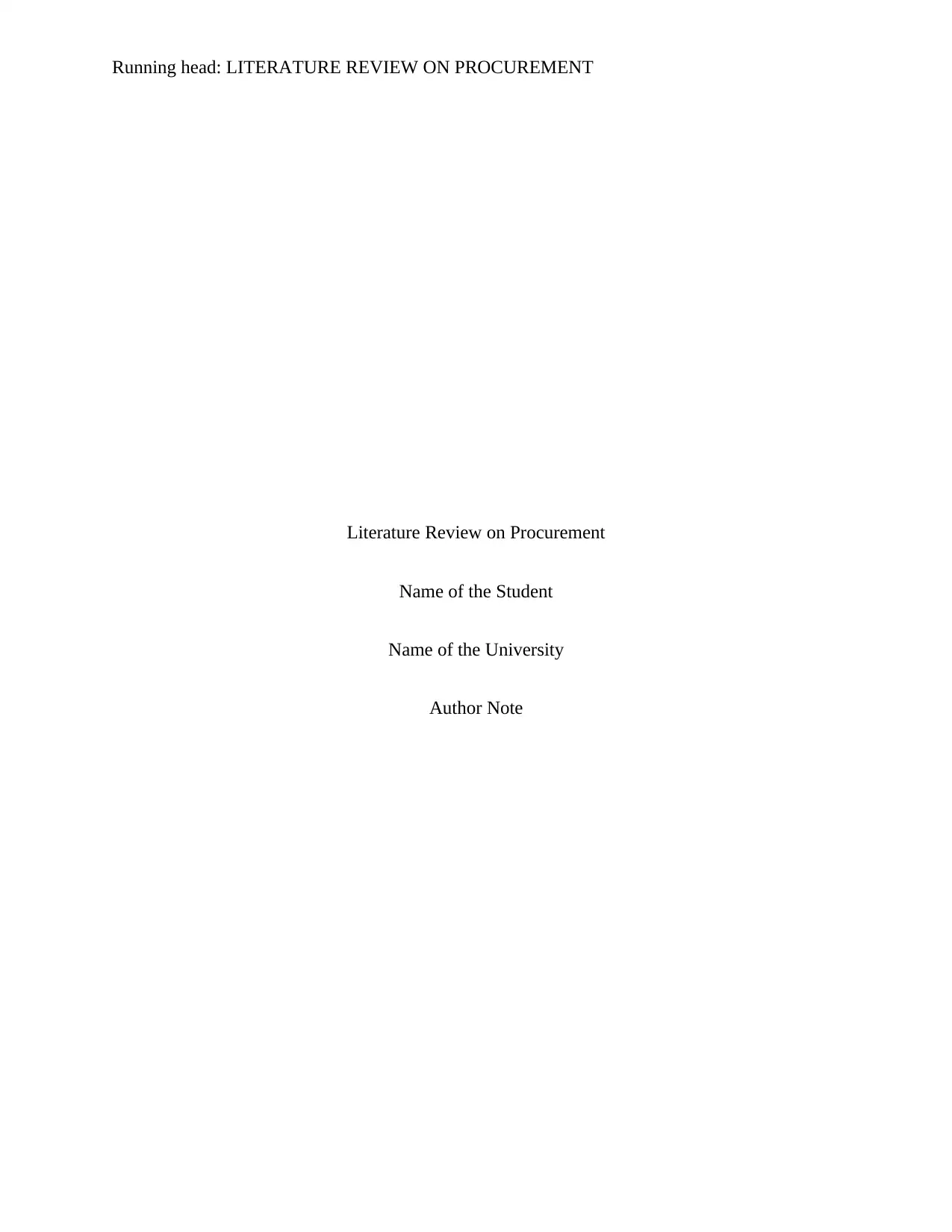
Running head: LITERATURE REVIEW ON PROCUREMENT
Literature Review on Procurement
Name of the Student
Name of the University
Author Note
Literature Review on Procurement
Name of the Student
Name of the University
Author Note
Paraphrase This Document
Need a fresh take? Get an instant paraphrase of this document with our AI Paraphraser
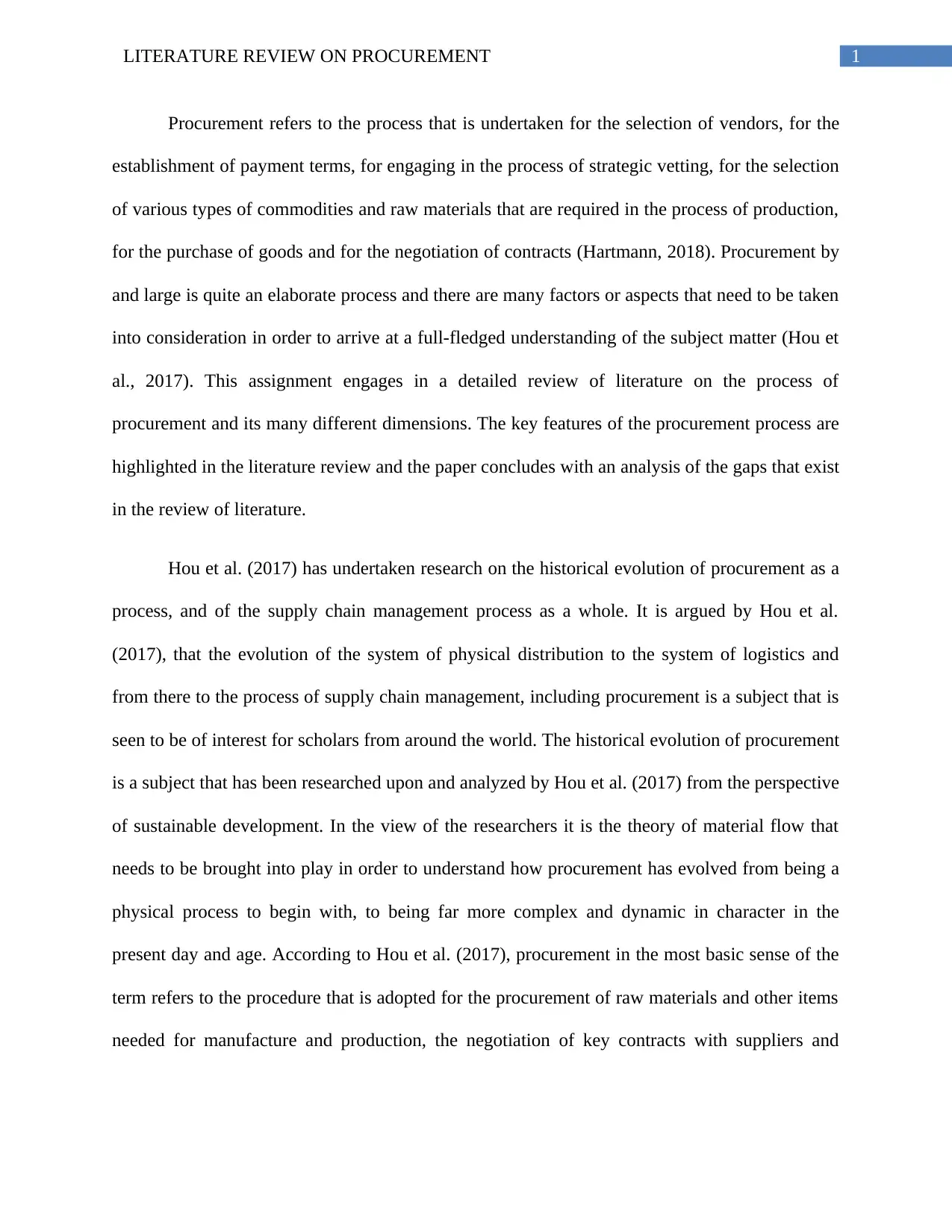
1LITERATURE REVIEW ON PROCUREMENT
Procurement refers to the process that is undertaken for the selection of vendors, for the
establishment of payment terms, for engaging in the process of strategic vetting, for the selection
of various types of commodities and raw materials that are required in the process of production,
for the purchase of goods and for the negotiation of contracts (Hartmann, 2018). Procurement by
and large is quite an elaborate process and there are many factors or aspects that need to be taken
into consideration in order to arrive at a full-fledged understanding of the subject matter (Hou et
al., 2017). This assignment engages in a detailed review of literature on the process of
procurement and its many different dimensions. The key features of the procurement process are
highlighted in the literature review and the paper concludes with an analysis of the gaps that exist
in the review of literature.
Hou et al. (2017) has undertaken research on the historical evolution of procurement as a
process, and of the supply chain management process as a whole. It is argued by Hou et al.
(2017), that the evolution of the system of physical distribution to the system of logistics and
from there to the process of supply chain management, including procurement is a subject that is
seen to be of interest for scholars from around the world. The historical evolution of procurement
is a subject that has been researched upon and analyzed by Hou et al. (2017) from the perspective
of sustainable development. In the view of the researchers it is the theory of material flow that
needs to be brought into play in order to understand how procurement has evolved from being a
physical process to begin with, to being far more complex and dynamic in character in the
present day and age. According to Hou et al. (2017), procurement in the most basic sense of the
term refers to the procedure that is adopted for the procurement of raw materials and other items
needed for manufacture and production, the negotiation of key contracts with suppliers and
Procurement refers to the process that is undertaken for the selection of vendors, for the
establishment of payment terms, for engaging in the process of strategic vetting, for the selection
of various types of commodities and raw materials that are required in the process of production,
for the purchase of goods and for the negotiation of contracts (Hartmann, 2018). Procurement by
and large is quite an elaborate process and there are many factors or aspects that need to be taken
into consideration in order to arrive at a full-fledged understanding of the subject matter (Hou et
al., 2017). This assignment engages in a detailed review of literature on the process of
procurement and its many different dimensions. The key features of the procurement process are
highlighted in the literature review and the paper concludes with an analysis of the gaps that exist
in the review of literature.
Hou et al. (2017) has undertaken research on the historical evolution of procurement as a
process, and of the supply chain management process as a whole. It is argued by Hou et al.
(2017), that the evolution of the system of physical distribution to the system of logistics and
from there to the process of supply chain management, including procurement is a subject that is
seen to be of interest for scholars from around the world. The historical evolution of procurement
is a subject that has been researched upon and analyzed by Hou et al. (2017) from the perspective
of sustainable development. In the view of the researchers it is the theory of material flow that
needs to be brought into play in order to understand how procurement has evolved from being a
physical process to begin with, to being far more complex and dynamic in character in the
present day and age. According to Hou et al. (2017), procurement in the most basic sense of the
term refers to the procedure that is adopted for the procurement of raw materials and other items
needed for manufacture and production, the negotiation of key contracts with suppliers and
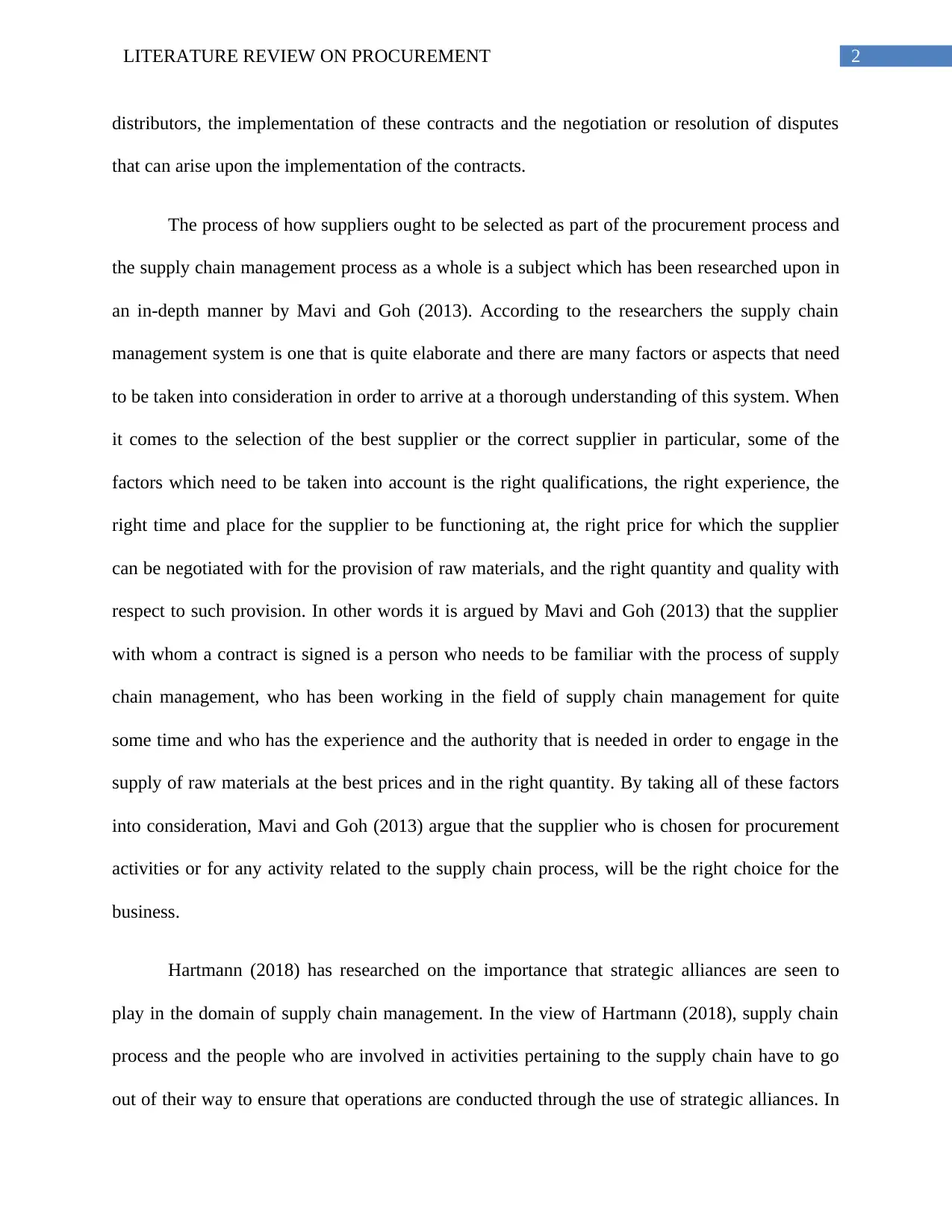
2LITERATURE REVIEW ON PROCUREMENT
distributors, the implementation of these contracts and the negotiation or resolution of disputes
that can arise upon the implementation of the contracts.
The process of how suppliers ought to be selected as part of the procurement process and
the supply chain management process as a whole is a subject which has been researched upon in
an in-depth manner by Mavi and Goh (2013). According to the researchers the supply chain
management system is one that is quite elaborate and there are many factors or aspects that need
to be taken into consideration in order to arrive at a thorough understanding of this system. When
it comes to the selection of the best supplier or the correct supplier in particular, some of the
factors which need to be taken into account is the right qualifications, the right experience, the
right time and place for the supplier to be functioning at, the right price for which the supplier
can be negotiated with for the provision of raw materials, and the right quantity and quality with
respect to such provision. In other words it is argued by Mavi and Goh (2013) that the supplier
with whom a contract is signed is a person who needs to be familiar with the process of supply
chain management, who has been working in the field of supply chain management for quite
some time and who has the experience and the authority that is needed in order to engage in the
supply of raw materials at the best prices and in the right quantity. By taking all of these factors
into consideration, Mavi and Goh (2013) argue that the supplier who is chosen for procurement
activities or for any activity related to the supply chain process, will be the right choice for the
business.
Hartmann (2018) has researched on the importance that strategic alliances are seen to
play in the domain of supply chain management. In the view of Hartmann (2018), supply chain
process and the people who are involved in activities pertaining to the supply chain have to go
out of their way to ensure that operations are conducted through the use of strategic alliances. In
distributors, the implementation of these contracts and the negotiation or resolution of disputes
that can arise upon the implementation of the contracts.
The process of how suppliers ought to be selected as part of the procurement process and
the supply chain management process as a whole is a subject which has been researched upon in
an in-depth manner by Mavi and Goh (2013). According to the researchers the supply chain
management system is one that is quite elaborate and there are many factors or aspects that need
to be taken into consideration in order to arrive at a thorough understanding of this system. When
it comes to the selection of the best supplier or the correct supplier in particular, some of the
factors which need to be taken into account is the right qualifications, the right experience, the
right time and place for the supplier to be functioning at, the right price for which the supplier
can be negotiated with for the provision of raw materials, and the right quantity and quality with
respect to such provision. In other words it is argued by Mavi and Goh (2013) that the supplier
with whom a contract is signed is a person who needs to be familiar with the process of supply
chain management, who has been working in the field of supply chain management for quite
some time and who has the experience and the authority that is needed in order to engage in the
supply of raw materials at the best prices and in the right quantity. By taking all of these factors
into consideration, Mavi and Goh (2013) argue that the supplier who is chosen for procurement
activities or for any activity related to the supply chain process, will be the right choice for the
business.
Hartmann (2018) has researched on the importance that strategic alliances are seen to
play in the domain of supply chain management. In the view of Hartmann (2018), supply chain
process and the people who are involved in activities pertaining to the supply chain have to go
out of their way to ensure that operations are conducted through the use of strategic alliances. In
⊘ This is a preview!⊘
Do you want full access?
Subscribe today to unlock all pages.

Trusted by 1+ million students worldwide
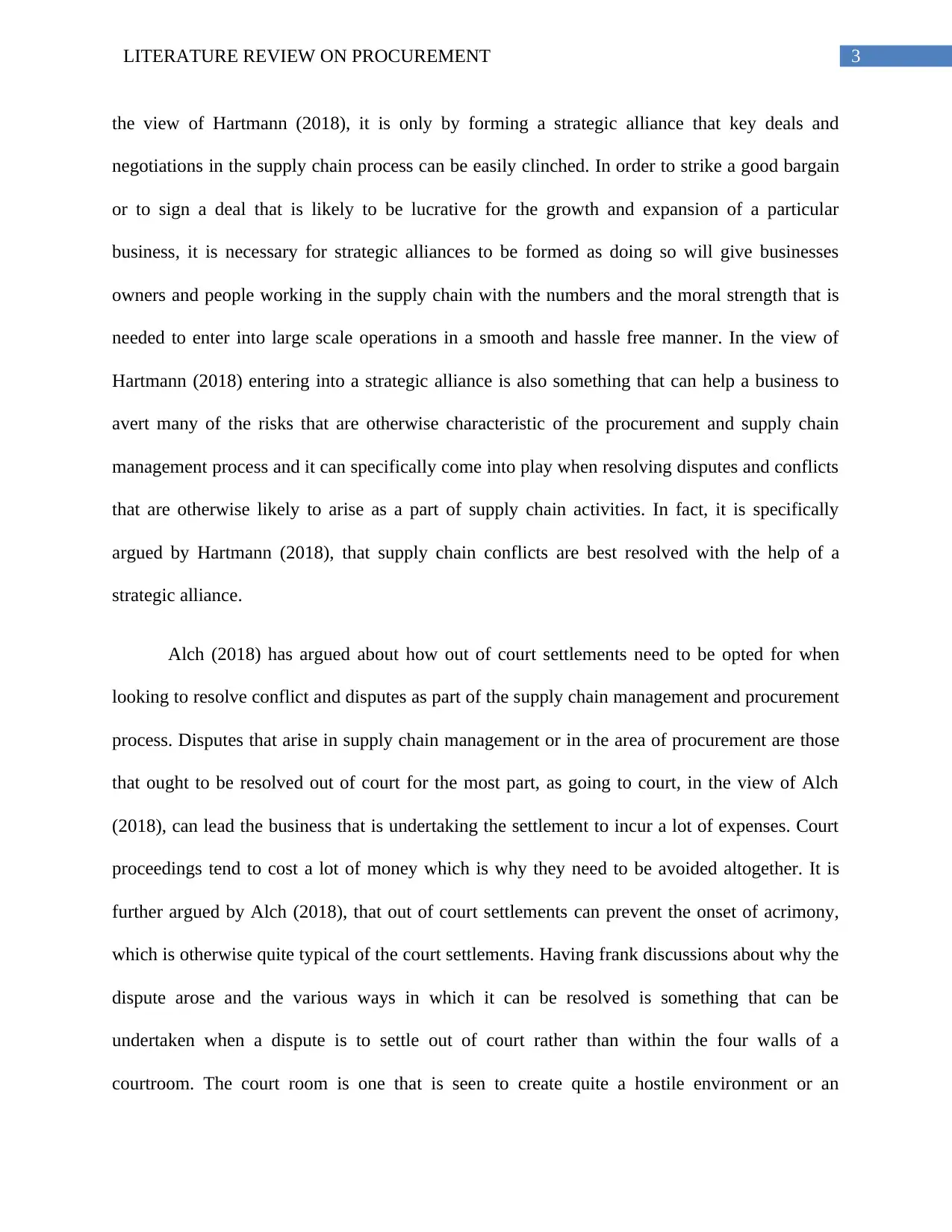
3LITERATURE REVIEW ON PROCUREMENT
the view of Hartmann (2018), it is only by forming a strategic alliance that key deals and
negotiations in the supply chain process can be easily clinched. In order to strike a good bargain
or to sign a deal that is likely to be lucrative for the growth and expansion of a particular
business, it is necessary for strategic alliances to be formed as doing so will give businesses
owners and people working in the supply chain with the numbers and the moral strength that is
needed to enter into large scale operations in a smooth and hassle free manner. In the view of
Hartmann (2018) entering into a strategic alliance is also something that can help a business to
avert many of the risks that are otherwise characteristic of the procurement and supply chain
management process and it can specifically come into play when resolving disputes and conflicts
that are otherwise likely to arise as a part of supply chain activities. In fact, it is specifically
argued by Hartmann (2018), that supply chain conflicts are best resolved with the help of a
strategic alliance.
Alch (2018) has argued about how out of court settlements need to be opted for when
looking to resolve conflict and disputes as part of the supply chain management and procurement
process. Disputes that arise in supply chain management or in the area of procurement are those
that ought to be resolved out of court for the most part, as going to court, in the view of Alch
(2018), can lead the business that is undertaking the settlement to incur a lot of expenses. Court
proceedings tend to cost a lot of money which is why they need to be avoided altogether. It is
further argued by Alch (2018), that out of court settlements can prevent the onset of acrimony,
which is otherwise quite typical of the court settlements. Having frank discussions about why the
dispute arose and the various ways in which it can be resolved is something that can be
undertaken when a dispute is to settle out of court rather than within the four walls of a
courtroom. The court room is one that is seen to create quite a hostile environment or an
the view of Hartmann (2018), it is only by forming a strategic alliance that key deals and
negotiations in the supply chain process can be easily clinched. In order to strike a good bargain
or to sign a deal that is likely to be lucrative for the growth and expansion of a particular
business, it is necessary for strategic alliances to be formed as doing so will give businesses
owners and people working in the supply chain with the numbers and the moral strength that is
needed to enter into large scale operations in a smooth and hassle free manner. In the view of
Hartmann (2018) entering into a strategic alliance is also something that can help a business to
avert many of the risks that are otherwise characteristic of the procurement and supply chain
management process and it can specifically come into play when resolving disputes and conflicts
that are otherwise likely to arise as a part of supply chain activities. In fact, it is specifically
argued by Hartmann (2018), that supply chain conflicts are best resolved with the help of a
strategic alliance.
Alch (2018) has argued about how out of court settlements need to be opted for when
looking to resolve conflict and disputes as part of the supply chain management and procurement
process. Disputes that arise in supply chain management or in the area of procurement are those
that ought to be resolved out of court for the most part, as going to court, in the view of Alch
(2018), can lead the business that is undertaking the settlement to incur a lot of expenses. Court
proceedings tend to cost a lot of money which is why they need to be avoided altogether. It is
further argued by Alch (2018), that out of court settlements can prevent the onset of acrimony,
which is otherwise quite typical of the court settlements. Having frank discussions about why the
dispute arose and the various ways in which it can be resolved is something that can be
undertaken when a dispute is to settle out of court rather than within the four walls of a
courtroom. The court room is one that is seen to create quite a hostile environment or an
Paraphrase This Document
Need a fresh take? Get an instant paraphrase of this document with our AI Paraphraser
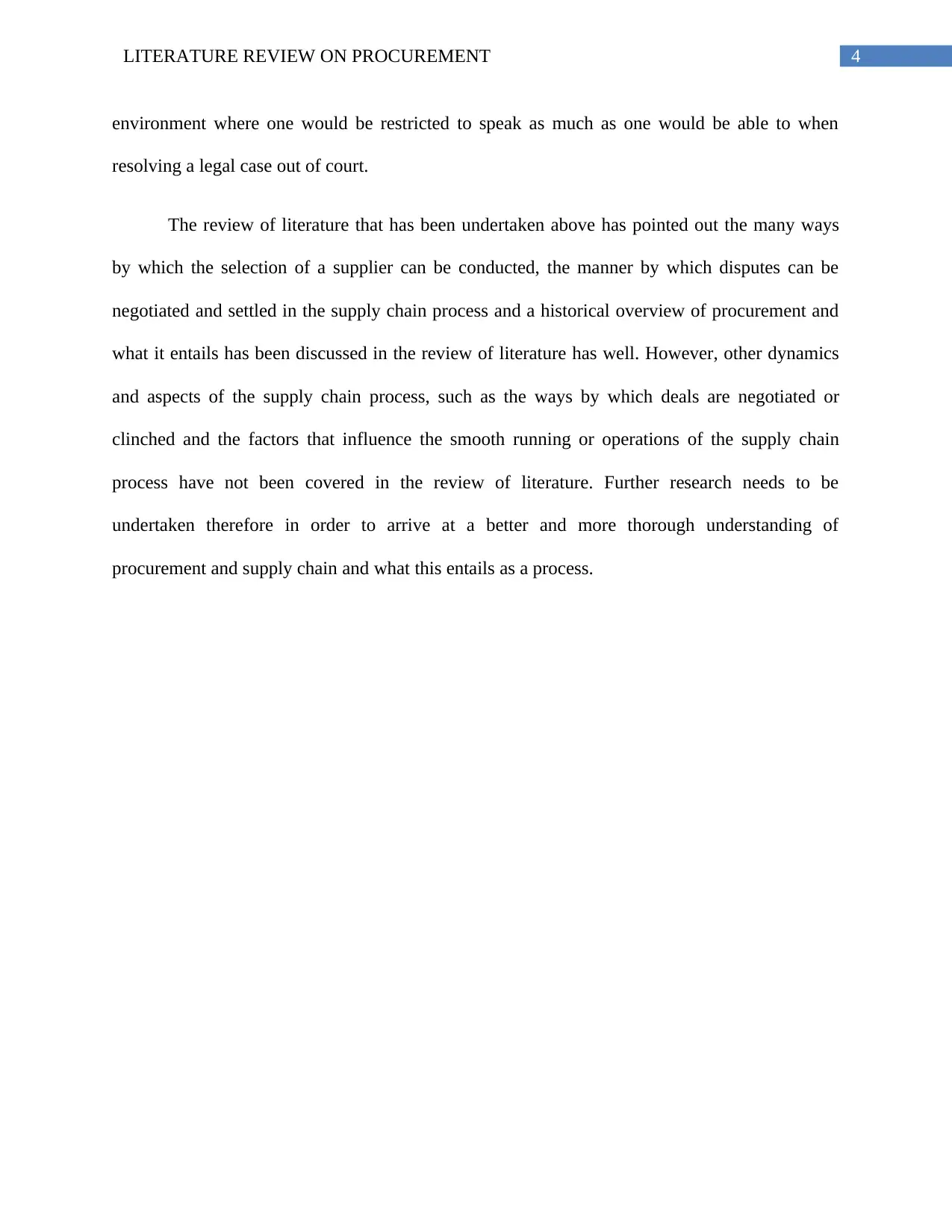
4LITERATURE REVIEW ON PROCUREMENT
environment where one would be restricted to speak as much as one would be able to when
resolving a legal case out of court.
The review of literature that has been undertaken above has pointed out the many ways
by which the selection of a supplier can be conducted, the manner by which disputes can be
negotiated and settled in the supply chain process and a historical overview of procurement and
what it entails has been discussed in the review of literature has well. However, other dynamics
and aspects of the supply chain process, such as the ways by which deals are negotiated or
clinched and the factors that influence the smooth running or operations of the supply chain
process have not been covered in the review of literature. Further research needs to be
undertaken therefore in order to arrive at a better and more thorough understanding of
procurement and supply chain and what this entails as a process.
environment where one would be restricted to speak as much as one would be able to when
resolving a legal case out of court.
The review of literature that has been undertaken above has pointed out the many ways
by which the selection of a supplier can be conducted, the manner by which disputes can be
negotiated and settled in the supply chain process and a historical overview of procurement and
what it entails has been discussed in the review of literature has well. However, other dynamics
and aspects of the supply chain process, such as the ways by which deals are negotiated or
clinched and the factors that influence the smooth running or operations of the supply chain
process have not been covered in the review of literature. Further research needs to be
undertaken therefore in order to arrive at a better and more thorough understanding of
procurement and supply chain and what this entails as a process.
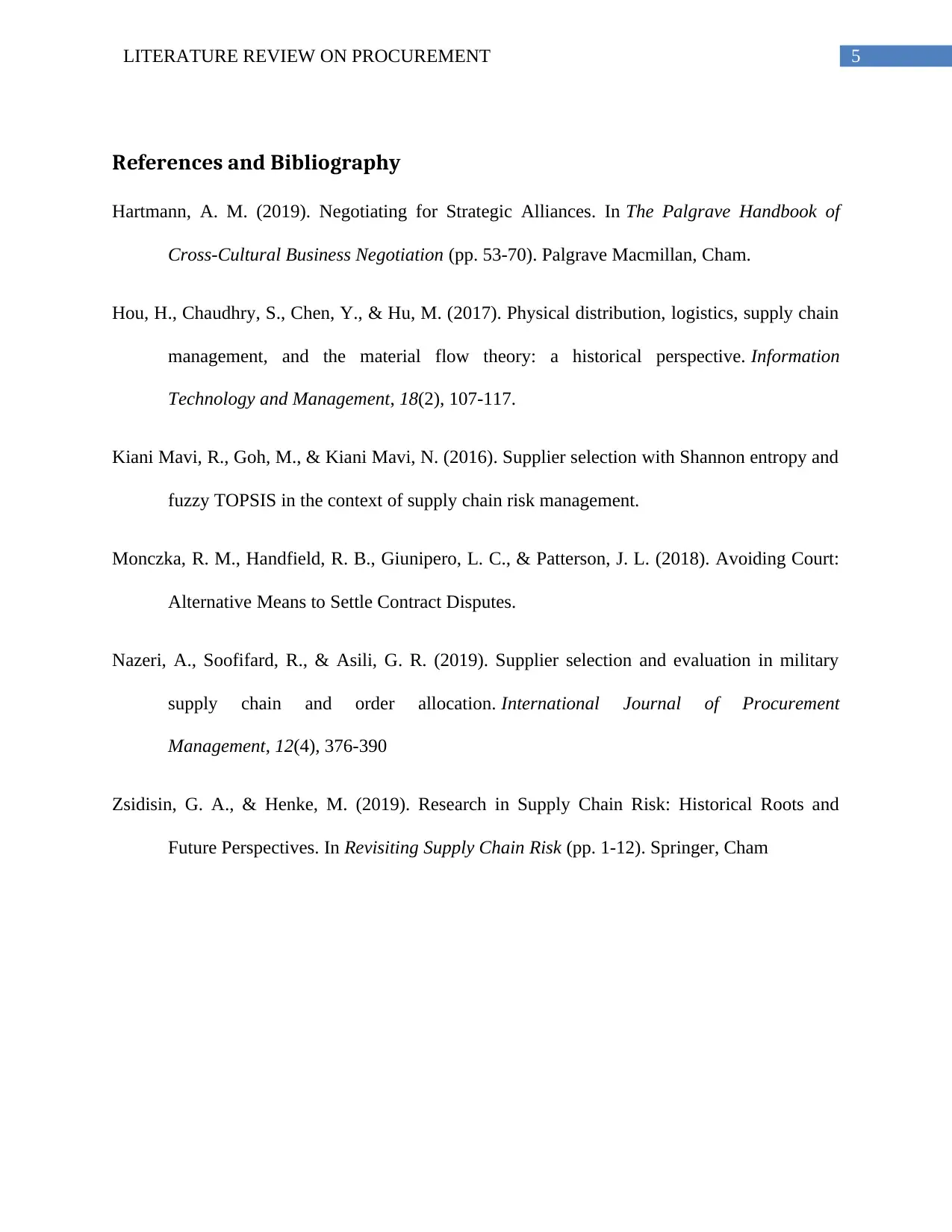
5LITERATURE REVIEW ON PROCUREMENT
References and Bibliography
Hartmann, A. M. (2019). Negotiating for Strategic Alliances. In The Palgrave Handbook of
Cross-Cultural Business Negotiation (pp. 53-70). Palgrave Macmillan, Cham.
Hou, H., Chaudhry, S., Chen, Y., & Hu, M. (2017). Physical distribution, logistics, supply chain
management, and the material flow theory: a historical perspective. Information
Technology and Management, 18(2), 107-117.
Kiani Mavi, R., Goh, M., & Kiani Mavi, N. (2016). Supplier selection with Shannon entropy and
fuzzy TOPSIS in the context of supply chain risk management.
Monczka, R. M., Handfield, R. B., Giunipero, L. C., & Patterson, J. L. (2018). Avoiding Court:
Alternative Means to Settle Contract Disputes.
Nazeri, A., Soofifard, R., & Asili, G. R. (2019). Supplier selection and evaluation in military
supply chain and order allocation. International Journal of Procurement
Management, 12(4), 376-390
Zsidisin, G. A., & Henke, M. (2019). Research in Supply Chain Risk: Historical Roots and
Future Perspectives. In Revisiting Supply Chain Risk (pp. 1-12). Springer, Cham
References and Bibliography
Hartmann, A. M. (2019). Negotiating for Strategic Alliances. In The Palgrave Handbook of
Cross-Cultural Business Negotiation (pp. 53-70). Palgrave Macmillan, Cham.
Hou, H., Chaudhry, S., Chen, Y., & Hu, M. (2017). Physical distribution, logistics, supply chain
management, and the material flow theory: a historical perspective. Information
Technology and Management, 18(2), 107-117.
Kiani Mavi, R., Goh, M., & Kiani Mavi, N. (2016). Supplier selection with Shannon entropy and
fuzzy TOPSIS in the context of supply chain risk management.
Monczka, R. M., Handfield, R. B., Giunipero, L. C., & Patterson, J. L. (2018). Avoiding Court:
Alternative Means to Settle Contract Disputes.
Nazeri, A., Soofifard, R., & Asili, G. R. (2019). Supplier selection and evaluation in military
supply chain and order allocation. International Journal of Procurement
Management, 12(4), 376-390
Zsidisin, G. A., & Henke, M. (2019). Research in Supply Chain Risk: Historical Roots and
Future Perspectives. In Revisiting Supply Chain Risk (pp. 1-12). Springer, Cham
⊘ This is a preview!⊘
Do you want full access?
Subscribe today to unlock all pages.

Trusted by 1+ million students worldwide
1 out of 6
Related Documents
Your All-in-One AI-Powered Toolkit for Academic Success.
+13062052269
info@desklib.com
Available 24*7 on WhatsApp / Email
![[object Object]](/_next/static/media/star-bottom.7253800d.svg)
Unlock your academic potential
Copyright © 2020–2025 A2Z Services. All Rights Reserved. Developed and managed by ZUCOL.





